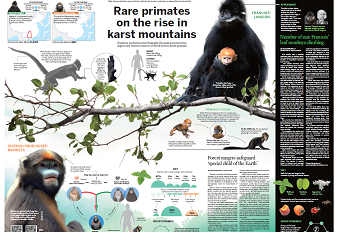Embroidering a future for tradition
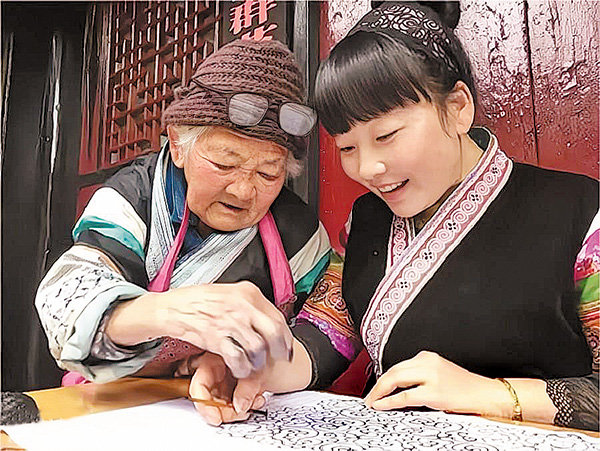
Under her mother's influence, Cai Qun (right) learns the batik and embroidery techniques.[Photo provided to China Daily]
Almost as soon as Cai Qun was born, 42 years ago, in a Miao village in Zhijin county, Guizhou province's Bijie city, her mother started to make her wedding dress. It took her around 15 years to finish the traditional Miao garment, as each step, from making the thread and weaving the fabric to each stitch of embroidery, was entirely handmade.
Inspired by her mother, Cai fell in love with the traditional batik and embroidery techniques. She has been learning these skills from her mother since she was 8.
When Cai also became a mother to a daughter, she took more than a decade to make a similar dress, with embroidered dragon heads, fishtails, butterflies and phoenixes, representing prosperity, happiness and good fortune.
Known as "fingertip ballet", the batik technique of the Miao ethnic group in Zhijin county, which has a history of more than 2,000 years, was enlisted as a national intangible cultural heritage last year.
In Zhijin, the embroiderers use a copper knife that has been dipped in liquid wax to outline a pattern on white cloth. They then embroider along the pattern.
"The patterns of the batik are passed down generation to generation, and the circular patterns, which are almost perfect, are all hand-drawn without the use of a ruler or compass," Cai says.
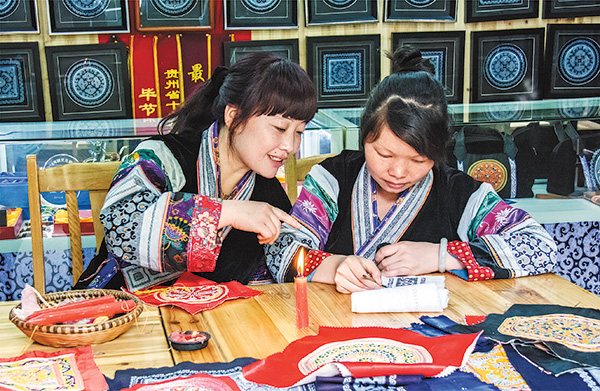
Cai (left) instructs an embroiderer to practice her batik skills.[Photo provided to China Daily]
As an inheritor of the Miao batik skill, Cai has won multiple awards for her batik and embroidery works. She also founded a Miao batik and embroidery company that gathers the female embroiderers in her village to produce handmade goods with intricate designs. The products sell well, both domestically and internationally.
"When I first started the business in 2009, only my husband and I were working, and then we gradually expanded to 20 people, then to 60 people, and now we have more than 600 staff members. In 2020, our output value reached over 22 million yuan ($3.15 million)," Cai says.
Cai left her village in 2000 at the age of 20 after her sister told her that she found a job for Cai in Guiyang, capital of Guizhou province. However, when she got there, she found that the job was collecting garbage at landfills. She later moved to Shenzhen, Guangdong province, to work as a waitress.
In 2007, she decided to move back to her hometown to better take care of her young daughter and she took part in a local competition in Bijie, with her batik work. She won second place with prize money of 2,000 yuan.
The competition inspired her. She realized that batik can be adapted to various products, especially souvenirs for tourists, so, in 2009, she decided to open a company that made such items.
"Growing up in a Miao village, we wear our ethnic clothes from childhood, and we use batik and embroidery to decorate our clothes and articles for daily use," she says.
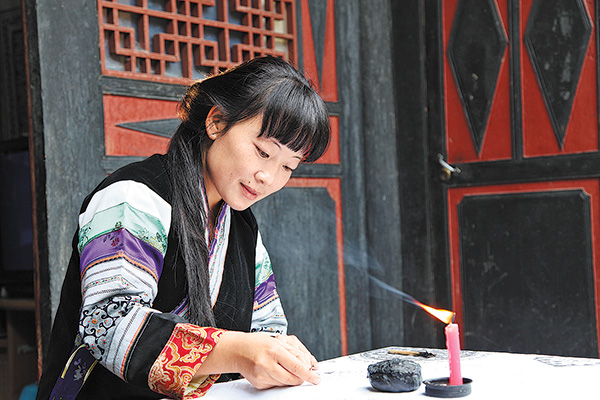
Cai is the inheritor of the Miao batik intangible cultural heritage.[Photo provided to China Daily]
"When I was a teenager, one of the items of clothing that my mother made for me was bought by a foreign visitor for more than 300 yuan, which was a huge amount of money at the time, and it made me realize the value of our batik and embroidery work," Cai recalls.
Cai took her embroidery products to a nearby scenic spot to sell, and tourists were impressed. As her business slowly grew, the local government offered her a loan to help her build a three-floor factory.
More of her fellow villagers, who had worked as migrant workers in other cities, moved back to the village to join Cai's company with their batik skills. This dovetailed with Cai's intention of expanding the business. She says that she hopes that "the sisters in the village will come back and return to their children".
"A life spending time at home with children is really good," she says.
Yang Zhongmei from Cai's village left to find work elsewhere. She could only return once every two years. She admits that her children barely knew her. She moved back to the village and was invited by Cai to learn batik skills.
"Now my family's situation has improved a lot. I make batik and my husband opened a restaurant at a nearby scenic spot. With Cai's help, we no longer have to go away to find work," she says.
The year 2013 was a special one for Cai, as she was elected as a deputy to the 12th National People's Congress. Besides being an entrepreneur, Cai also pays attention to the inheritance of batik embroidery.
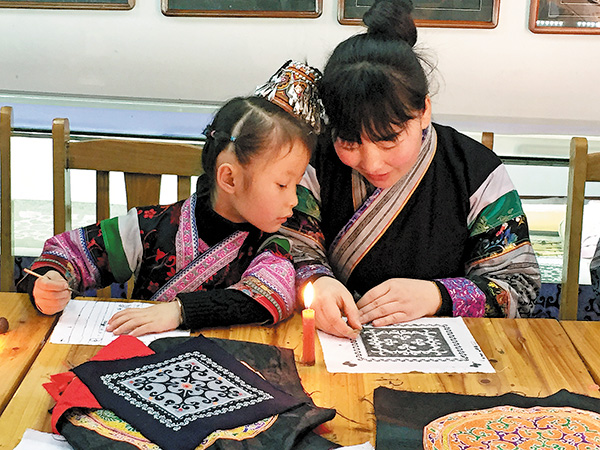
Cai teaches local children with batik skills.[Photo provided to China Daily]
Cai notices that young women prefer modern clothes, which are easy to wear and fashionable, and at the same time, young Miao people move away for work, leaving fewer people to master the batik skills.
She hosts batik classes for local children and, with her business expanding, she hopes to attract more people to move back.
Cai has developed new products, such as batik square towels, silver ornaments and Miao tops, as well as traditional Miao clothes. Her products have been sold in the United States and Canada.
In Cai's mind, the first step to innovating batik design is to add more elements relevant to modern daily life, and the color should be more contemporary.
"We should also combine batik and Miao embroidery to make the blue and white batik works more interesting," Cai says. She adds that developing local characteristics by integrating more traditional cultural elements is another way to make the products appealing.
Cai and her team also design shirts and dust coats with batik elements to attract young customers.
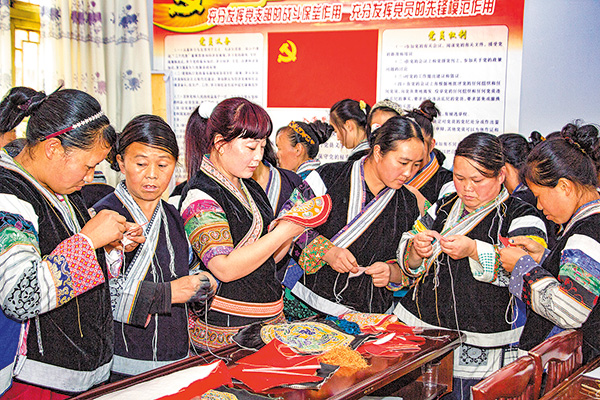
Cai Qun (third from left) leads local women in making batik and Miao embroidery works.[Photo provided to China Daily]
After contacting more brands and markets, Cai has begun experimenting more. She has tried dyeing a romantic purple color using onion, and creating a beautiful pink from azaleas. She uses these two colors to dye four-piece bedding sets, which sell for more than 4,000 yuan a set, and are consistently a best-seller.
She also founded a batik museum to display complex batik paintings and exquisite embroidery patterns, including fish pattern wall hangings and some of her award-winning works.
The museum was named a provincial intangible cultural heritage productive protection demonstration base by the provincial department of culture and tourism of Guizhou province.
Lin Feng, 25, Cai's daughter, joined her mother's batik business after graduation. She has inherited around 80 percent of Cai's skills, according to her mother. Last year, Lin finished a batik order with three embroiderers.
Lin also hosts livestreaming shows to sell their new batik embroidery bags online. "The craftsmanship passed down from our ancestors is quite valuable and it can allow us to have a good life," Lin says. "My daughter will also learn to inherit the Miao embroidery in the future."
Wang Jin contributed to the story.
京ICP备13028878号-8







 Overview
Overview Guiyang
Guiyang Guian New Area
Guian New Area Liupanshui
Liupanshui Anshun
Anshun Qianxinan
Qianxinan Qiandongnan
Qiandongnan Qiannan
Qiannan Zunyi
Zunyi Tongren
Tongren Bijie
Bijie Guizhou fosters cross-cultural bonds in Europe
Guizhou fosters cross-cultural bonds in Europe 18th Guizhou Tourism Industry Development Conference
18th Guizhou Tourism Industry Development Conference 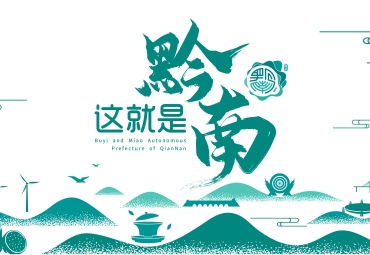 Discover natural beauty in Qiannan, Guizhou
Discover natural beauty in Qiannan, Guizhou 
